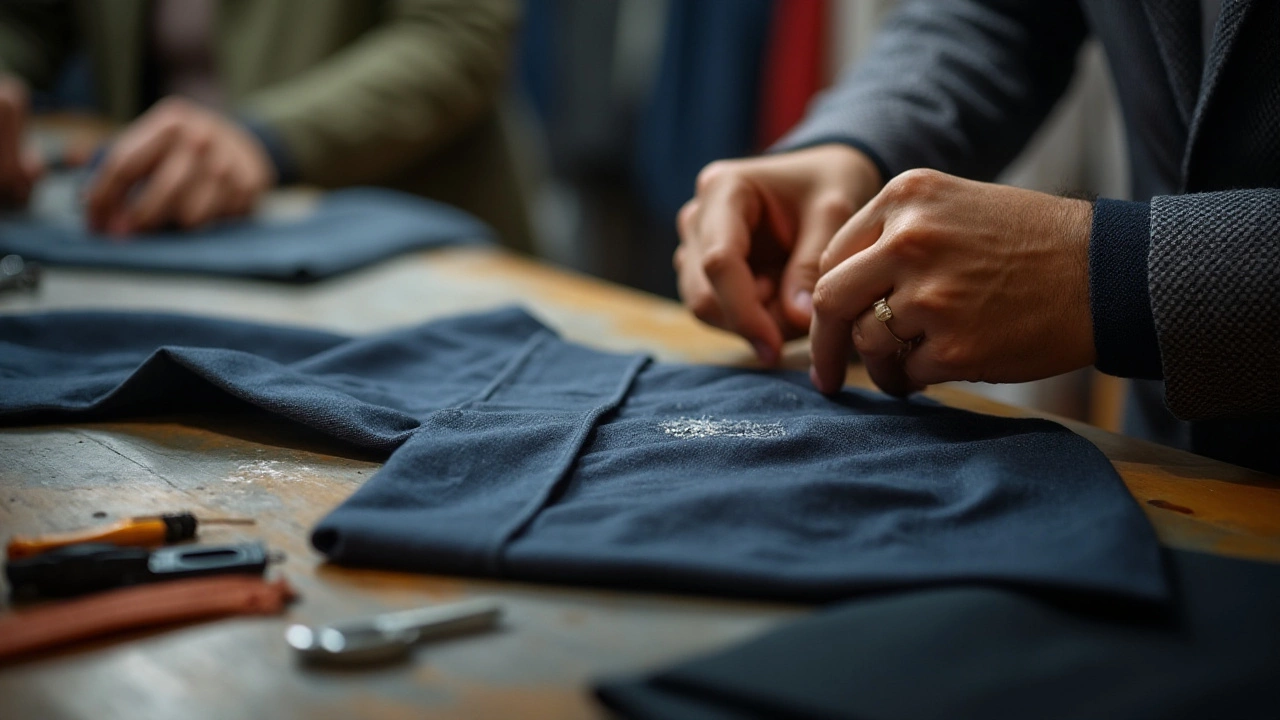How to Find the Perfect Suit at an Affordable Price

- Cleo Fairchild
- 21 January 2025
- 0 Comments
Dressing well often starts with a great suit, a hallmark of elegance and timeless style. Yet, the quest for the perfect suit can feel daunting when you consider the wide range of prices and styles available. One might wonder how much you should really pay to secure both quality and style.
It’s essential to know what drives the cost of a suit. From the choice of fabric to the intricacies of tailoring, several elements contribute to the final price tag. Understanding these factors can help you in making a more informed decision.
Discovering a suit that offers both quality and affordability is more than a matter of chance. By weighing aspects such as fabric type, construction, and fit, you can find a suit that marries comfort with sophistication – all without exhausting your savings.
Understanding Suit Prices
When it comes to men's fashion, suits stand as an enduring symbol of sophistication and style. Yet, the price of a men's suit can vary immensely, sometimes bewilderingly so. To truly understand the pricing of suits, we must peel back the layers that dictate their cost. At its core, the price of a suit is primarily driven by three components: fabric quality, construction, and brand reputation. Each of these elements contributes a particular weight to the suit's final value, making it crucial to discern what exactly you are paying for with each purchase.
Fabric is often the first differentiator of price, with luxury wools, linens, and silks at the higher end of the spectrum. These materials not only offer superior drape and comfort, but they also enhance durability and longevity. Yet, it's not just about the type of fabric; it’s about the weave, the softness, and the weight that these fabrics bring to the table. Cheaper suits might opt for blends or synthetics, which while cost-effective, may compromise the elegance of the garment. In fact, as one tailoring expert noted, "The fabric you choose is the canvas; everything else is simply how you paint on it".
Apart from fabric, the construction of a suit plays a pivotal role in determining its price. There's a stark difference between a suit made with fused construction versus one crafted with a full canvas or half canvas approach. Fused suits, where layers are glued rather than sewn, often come at a fraction of the cost but may lack the flexibility and comfort of their canvas counterparts. Meanwhile, fully canvassed suits, meticulously sewn, offer an unparalleled fit and structure, albeit at a price that reflects their intricate craftsmanship. For the uninitiated, recognizing these subtleties can be the key to understanding why one suit might command a higher price than another.
Lastly, the brand reputation of a suit also has a significant impact on its price. Renowned brands offer a certain allure, promising not just a suit, but a statement of identity and status. They often justify their pricing with exclusivity, unparalleled service, and heritage. Known names like Savile Row tailors or Italian luxury brands have mastered the art of bespoke and made-to-measure suits, appealing to those who prize tradition and elite craftsmanship. Yet, emerging designers sometimes offer comparable quality and style at more attainable prices, providing opportunities to secure a quality suit without the sticker shock.
As we navigate this rich tapestry of factors, it becomes evident that understanding suit pricing requires more than simply glancing at the price tag. It invites an exploration of materiality, craftsmanship, and heritage. With the right knowledge, purchasing a suit transforms from a simple transaction to an informed and savvy investment in personal style.

Factors Influencing Cost
When it comes to purchasing a men's suit, several elements directly impact its cost. One of the most significant factors is the choice of fabric. High-quality materials such as wool, cashmere, and silk often fetch higher prices due to their durability and luxurious feel. Wool, for example, is a versatile and breathable fabric that lends itself perfectly to suits meant for year-round wear. The fineness of the wool, measured in 'super numbers,' indicates a higher thread count and thus a more expensive fabric.
Next, we delve into the art of suit construction. A suit's structure, determined by whether it is fused, half-canvassed, or fully canvassed, plays a crucial role in its price determination. Fused suits are the least expensive, as they involve gluing a piece of fabric to the inside of the jacket, while fully canvassed suits feature a stitched interfacing that conforms to the body's shape, offering impeccable drape and comfort. The intricacies of the craftsmanship required for this method explain why fully canvassed suits reside at the uppermost end of the pricing spectrum.
Brand reputation is another consideration that often equates to higher costs. Brands like Savile Row or Armani are renowned not only for their historical significance and design excellence but also for their commitment to quality and service, which invariably adds to the overall cost. It's akin to purchasing a piece of art; choosing a suit from a reputable designer provides an assurance of a style that resonates with sophistication and elegance, a sentiment endorsed by many fashion aficionados.
"A well-made suit can feel like armor for the soul," observed Thom Browne, an acclaimed suit designer known for his meticulous attention to detail. This statement encapsulates the transformative power of wearing a suit that fits and is made from superior craftsmanship.
Also noteworthy is the distinction between off-the-rack and bespoke suits. While ready-to-wear suits offer convenience and affordability, bespoke suits promise the unparalleled sensation of a perfect fit. The bespoke process involves multiple fittings and the keen eye of a skilled tailor, factors contributing to the premium pricing. This customization ensures that each curve and contour is considered, turning the suit into a unique extension of the wearer.
Lastly, geographical location and economic factors also subtly affect pricing. Suits purchased from traditional fashion capitals, such as London or Milan, might reflect higher prices due to the regions' status and associated logistics. These elements, combined with the manufacturing costs, are amalgamated into what you end up paying at the register. It's important to approach your purchase with a clear understanding of these factors that play a pivotal role in deciding where your hard-earned money is directed. By appreciating the components that justify the cost, you are better equipped to make a choice that aligns with your budget while securing a quality suit that stands the test of time.

Finding Quality on a Budget
For many, the pursuit of the ideal men's suit embodies both an art and a science, especially when searching for quality that doesn’t break the bank. It's crucial to delve into the craftsmanship behind suits, as this can fundamentally affect the price. One significant aspect to consider is the fabric. Wool is often regarded as the gold standard due to its durability and elegance, but it’s worth exploring wool blends or even high-quality synthetics that provide similar aesthetics at a lower cost.
Knowing where to look is just as important. As many seasoned sartorial enthusiasts will attest, outlet stores and sales, whether in-store or online, can be a treasure trove of discounted quality suits. These venues often carry pieces from past seasons at a fraction of the price, making them ideal for the discerning buyer who doesn't mind last season’s styles. Shopping during specific sales events, such as the post-holiday clearance sessions, can often yield substantial savings.
Embrace the world of second-hand shopping. The pre-owned market offers a plethora of designer pieces that have barely been worn. Thrift shops or online platforms dedicated to pre-loved fashion can be worthwhile if you're willing to search. Often, tailoring such finds to fit your silhouette perfectly can transform a basic suit into something extraordinary.
Consider Alterations
One often overlooked path to acquiring an excellent suit on a budget is the power of tailoring. Even an off-the-rack suit can achieve a bespoke look with the right alterations. Invest in a good tailor who knows how to adjust the fit to your body. Alterations like shortening sleeves, taking in the jacket, or adjusting the trouser length can make a significant difference. It’s a small price to pay for what could be a custom-like fit, enhancing the suit’s appearance exponentially.
The branding of a suit can also dictate its cost, yet labels aren’t everything. Identify smaller or local designers who offer products just as well-made as their high-end counterparts. These brands often focus on quality to build their reputation, providing excellent value at a lower price point. Look around your area or research new and upcoming names in the fashion industry.
According to GQ Magazine, "A well-fitted suit from an independent brand can stand toe to toe with designer labels—often outlasting them in style and substance."
Lastly, think about the cost per wear. While an upfront cost may appear significant, investing in a durable, versatile suit that you'll wear frequently equates to lower expenditure over time. Black, navy, and grey suits are timeless options that offer the most versatility, allowing you to wear them repeatedly with different shirts and ties, making them a wise investment.

Value of Tailoring
It's one thing to buy a quality suit, but the real magic lies in how well it fits your body. And that is where tailoring comes into play. A well-tailored suit can instantly boost your appearance by accentuating your physique and providing a polished look that off-the-rack suits often miss. Tailoring doesn't just adjust for size; it customizes your suit in a manner that aligns with your unique posture and body proportions. This level of personalization can transform an average suit into something truly extraordinary, because it flatters you in all the right places.
Tailors are skilled artisans. They consider nuances like the drape of the fabric, ease of movement, and even the harmony of button placement. Each small adjustment—whether it's nipping the waist, shortening the sleeves, or adding cuffs—can make a monumental difference. When you tailor a suit, you ensure the sleeves hit that just right spot on your wrist and the trousers break perfectly over your shoes. There's an age-old saying that fit is king, and it's easy to see why when you compare a tailored suit to one that's just been pulled off the shelf.
If you're on a budget, you might think that bespoke or custom tailoring is out of reach; however, many modern tailoring services offer affordable pricing options without compromising on quality. These services often cater to both high-end clients and those seeking value-driven options, making it possible to enhance a suit's fit without excessive spending. Investing in tailoring services can be especially cost-effective in the long run, considering it extends the lifespan of a suit by ensuring it remains fashionable and fits perfectly season after season.
Connoisseurs and everyday gentlemen alike recognize tailoring as a crucial aspect of building a sophisticated wardrobe. According to renowned fashion designer Tom Ford, "Dressing well is a form of good manners." This idea encapsulates the importance of tailoring, as it shows an attention to detail and a respect for presentation. In the bustling realm of men's suits, tailoring emerges as a tangible manifestation of elegance, where modern designs meet the craft of traditional tailoring to create a synergy that elevates the ordinary to extraordinary.


